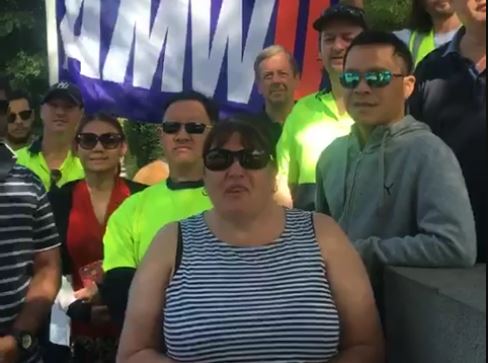
Workers at Australian Paper’s manufacturing facility in Preston are picketing to demand a pay increase and better conditions.
Specifically, adjusters, operators, and packers at the manufacturing plant are taking part in the action, covering 88 workers at the plant.
Their current agreement expired nine months ago, and attempts to negotiate a new agreement have failed, with workers requesting a 2.5 per cent annual wage increase, on a three year deal, and the company counter-offering a four-year agreement, with a pay rise freeze for the first year, followed by 2 per cent, 2 per cent, and 2.5 per cent increases over the next three years.
Those picketing say they only want the same rise given to the warehouse workers, which was 2.5 per cent.
The Preston factory produces envelope papers, folders and filing products, note and lecture pads, business books, scrap and exercise books, adhesive mailing labels, playing cards.
Workers at the company’s Maryvale production mill agreed to take a pay cut last year to ensure the long-term viability of the plant, which is celebrating its 80th year.
Craig Dunn, general manager Marketing and Sustainability, Australian Paper, says, “The discussions we have been having remain confidential between Australian Paper and our employees at Preston. Australian Paper is committed to reaching an agreement that represents the best outcome for the company and our employees. We are not sure how long the current situation will continue, but we are seeking to reach a mutual acceptable outcome at the earliest time.
“We have measures in place to meet the needs of our customers during this phase of the discussions.”
The real issue, the workers say, is the reclassification of the workplace structure, which would define pay for roles that is lower than what some currently receive, with a possible end result being that it would take several years for certain workers to end up with a larger pay packet.
Margaret Peacock, Australian Paper worker, and union representative says, “We had our union meeting, everyone voted to go out on strike. We are under a protective action here. We have 88 union members, and have different groups of people coming, alternating shifts between morning and afternoon.
“It is about conditions at work. They are trying to take four RDOs from us, and grandfather our wages. For the 80 per cent of us over the new wage structure, we will not get a rise until the other newer workers catch up.
“Nobody agrees with that. We are out because of those two reasons, and people feel strongly about it, even the 20 per cent who will not suffer as much.
“I have been here at this job for 33 years working as a packer. We feel really strongly, but we are not expecting to hear from the company until next week. They are hoping we will back down.”
Dean Griffith is the AMWU organiser present, and says, “The negotiations for the enterprise agreement were strung out for nine months. We thought we were close to getting an agreement about mid-way through, all of the sudden the company changed its tune in the past couple of months, and started attacking all the conditions.
“The employees here have 16 RDOs a year, and the company wants to drop that to 12. As they put it to me in plain English, the only good thing about this place is the RDOs.
“The company is essentially saying thanks for being loyal over these years, but now we want to freeze your wages until the others catch up.
“The picket line is strong and active, everyone is in good spirits, but are pissed off at the company. Margaret has been here 33 years and is on $21.50 an hour. That gives you an idea of how many increases she has been given down the line, being a 33-year employee.”
The latest figures from the Australian Bureau of Statistics paint a poor picture for wage growth, particularly in the private sector, where only 2.4 per cent of workers have seen new agreements, a 25-year low.
Since September 2014, new wage agreements have almost halved.
Those who have been given pay rises have seen an average pay pump of 2.2 per cent, barely keeping track with inflation, with manufacturing workers sitting just above that figure, increasing by 2.4 per cent on average.
Print workers on award wages were given a legislated increase in pay last year, 3.3 per cent, while the minimum wage was also bumped up.
Comment below to have your say on this story.
If you have a news story or tip-off, get in touch at editorial@sprinter.com.au.
Sign up to the Sprinter newsletter

This company is full of greed.
No money for its employees, yet 2 weeks before Christmas, the powers to be- employee a new engineering manager.